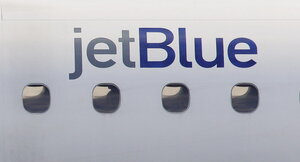JetBlue expands 'Mint' service to lure business class passengers
In a bid to distinguish itself from competitors like American and United, JetBlue has announced the extension of 'Mint,' a premium feature with lie-flat seats, to even more major transcontinental routes, including San Diego-Boston and Seattle-New York.

A JetBlue logo is displayed on the side of a jet as it taxis at Boston's Logan International Airport (Jan. 20, 2011).
Stephan Savoia/AP/File
If you’re flying business class, JetBlue wants to make sure you’re flying with them.
In a bid to distinguish itself from competitors like American and United, JetBlue has announced the extension of “Mint,” a premium feature with lie-flat seats, to even more major transcontinental routes, including San Diego-Boston and Seattle-New York.
“Mint helped traditional business class travelers realize there is a better way,” JetBlue President and CEO Robin Hayes, said in a press release. “Our plan has long called for strategic growth of Mint on these valuable transcontinental routes, and now is the right time for us to capture this opportunity to bring much needed competition where customers are facing dwindling choices.”
JetBlue’s announcement comes two weeks after it expanded Mint to flights in the Caribbean, making it the only airline to feature lie-flat service on its regular flights there. It also arrives just days after losing out on a bid to acquire Virgin America at auction. Alaska Airlines agreed to pay $2.6 billion for the small airline, which is based in San Francisco. Mergers such as these have made the airline industry more narrow and competitive, but it has also led to customer service changes, some of them subtle and others more noticeable, as each airline bids for customer retention and loyalty.
In the past, JetBlue has differentiated itself from the pack by keeping fee-free service and related perks that resulted in both high customer satisfaction and record profits; the airline made $47 million in the last three months of 2013, due primarily to low fuel prices and higher ticket prices. That system changed in November 2014 when, under new management and pressure from Wall Street, the company announced that it would be restricting legroom and introducing baggage fees. JetBlue first introduced Mint in 2014 as a way to attract business-class travelers and is billed as a lower-cost and more modern version of traditional business class.
The airline is not alone in introducing changes that cater to top-tier customers while simultaneously leaving those paying less in the lurch. JetBlue’s Mint expansion reflects the realities of the airline industry, which wants to turn a profit amid high customer demand and low fuel prices. Tacking fees on nearly every associated customer experience has been an effective way of doing so: Delta’s revenue for the first quarter of 2016 is forecasted at $9.25 billion.
Fees for everything from extra bags to additional legroom are also a way for so-called “legacy carriers” like Delta, United, and American to remain financially competitive against budget airlines like Southwest and Spirit. Although Spirit has the highest number of customer complaints per passenger of any airline, according to data from the US Public Interest Research Group (PIRG), its profits have grown over the years as customers look to save money and fuel prices drop.
But there are some small bright spots amid shrinking seat size and increasing fees. In February, United reintroduced free snacks to economy class, citing a need to 'refocus on the big and little things' that will improve customers' experience.

